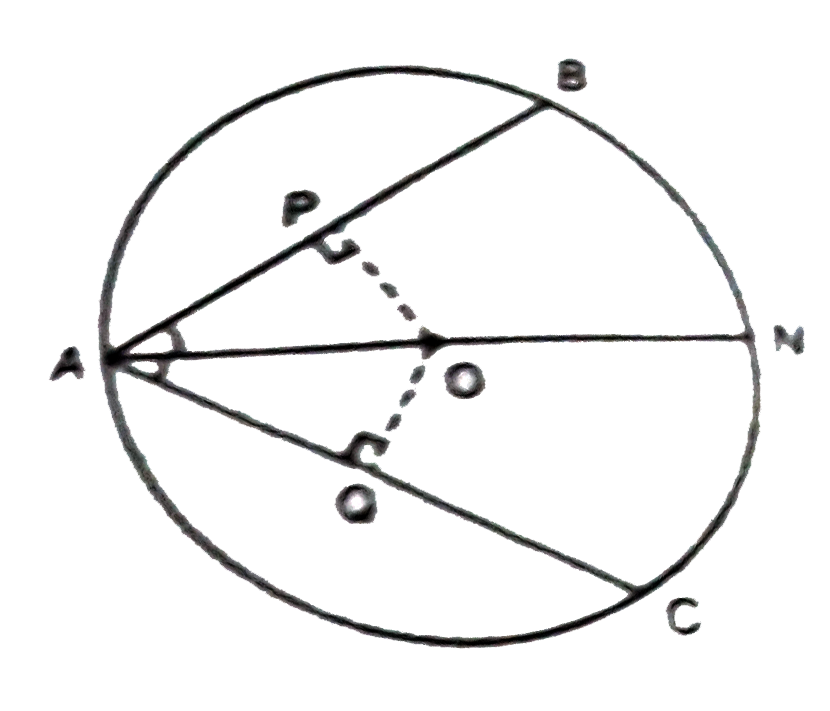The curve for which the length of the normal is equal to the length of the radius vector is/are (a) circles (b) rectangular hyperbola (c) ellipses (d) straight lines
To solve the problem of finding the curves for which the length of the normal is equal to the length of the radius vector, we will follow these steps:
Step 1: Define the Length of the Normal and the Length of the Radius Vector
The length of the normal to a curve at a point is given by:
n=y√1+(dydx)2
The length of the radius vector from the origin to the point (x,y) is given by:
r=√x2+y2
Step 2: Set the Lengths Equal
According to the problem, we need to set these two lengths equal:
y√1+(dydx)2=√x2+y2
Step 3: Square Both Sides
To eliminate the square roots, we square both sides:
y2(1+(dydx)2)=x2+y2
Step 4: Simplify the Equation
Expanding the left side gives:
y2+y2(dydx)2=x2+y2
Now, subtract y2 from both sides:
y2(dydx)2=x2
Step 5: Rearranging the Equation
Rearranging gives us:
(dydx)2=x2y2
Taking the square root of both sides, we have:
dydx=xyordydx=−xy
Step 6: Solve the Differential Equations
1. For dydx=xy:
- Cross-multiplying gives:
ydy=xdx
- Integrating both sides:
∫ydy=∫xdx
y22=x22+C
- Multiplying through by 2 gives:
y2=x2+C′
- This represents a rectangular hyperbola.
2. For dydx=−xy:
- Cross-multiplying gives:
ydy+xdx=0
- Integrating both sides:
∫ydy+∫xdx=0
y22+x22=C
- Multiplying through by 2 gives:
y2+x2=C′
- This represents a circle.
Conclusion
The curves for which the length of the normal is equal to the length of the radius vector are:
- A rectangular hyperbola (from the first differential equation).
- A circle (from the second differential equation).
Thus, the correct options are (a) circles and (b) rectangular hyperbola.
The length of the normal to a curve at a point is given by:
n=y√1+(dydx)2
r=√x2+y2
According to the problem, we need to set these two lengths equal:
y√1+(dydx)2=√x2+y2
To eliminate the square roots, we square both sides:
y2(1+(dydx)2)=x2+y2
Expanding the left side gives:
y2+y2(dydx)2=x2+y2
y2(dydx)2=x2
Rearranging gives us:
(dydx)2=x2y2
dydx=xyordydx=−xy
1. For dydx=xy:
- Cross-multiplying gives:
ydy=xdx
- Integrating both sides:
∫ydy=∫xdx
y22=x22+C
- Multiplying through by 2 gives:
y2=x2+C′
- This represents a rectangular hyperbola.
- Cross-multiplying gives:
ydy+xdx=0
- Integrating both sides:
∫ydy+∫xdx=0
y22+x22=C
- Multiplying through by 2 gives:
y2+x2=C′
- This represents a circle.
The curves for which the length of the normal is equal to the length of the radius vector are:
- A rectangular hyperbola (from the first differential equation).
- A circle (from the second differential equation).
Topper's Solved these Questions
- COMPLEX NUMBERS AND QUADRATIC EQUATIONSBook:CENGAGE ENGLISHChapter:COMPLEX NUMBERS AND QUADRATIC EQUATIONSExercise:All Questions
Explore 886 Videos
- DIFFERENT PRODUCTS OF VECTORS AND THEIR GEOMETRICAL APPLICATIONS Book:CENGAGE ENGLISHChapter:DIFFERENT PRODUCTS OF VECTORS AND THEIR GEOMETRICAL APPLICATIONS Exercise:Multiple correct answers type
Explore 11 Videos
Similar Questions
Find the curve for which the length of normal is equal to the radius vector.
View SolutionFind the curves for which the length of normal is equal to the radius vector.
View SolutionThe curve for which the ratio of the length of the segment intercepted by any tangent on the Y-axis to the length of the radius vector is constant (k), is
View SolutionThe length of normal at any point to the curve, y=ccosh(xc) is
View SolutionFor a curve (length of normal)^2/(length of tangent)^2 is equal to
View SolutionThe line y=mx+c will be a normal to the circle with radius r and centre at (a,b) if
View SolutionThe curve with the property that the projection of the ordinate on the normal is constant and has a length equal to a is
View SolutionProve that the chords inclined on the same angle to the radius or diameter of a circle are equal in length.

View SolutionThe length of the transverse axis of the rectangular hyperbola xy=18 is (a) 6 (b) 12 (c) 18 (d) 9
View SolutionFind the minimum length of radius vector of the curve a2x2+b2y2=1
View Solution
